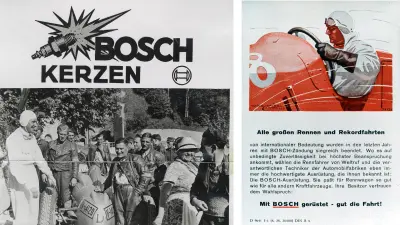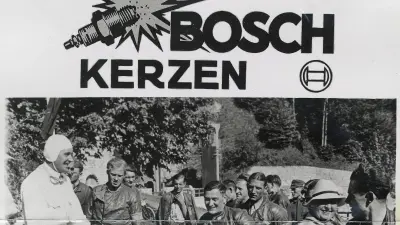Bosch motorsport history

The link between Bosch and motorsport started early on in 1901, when a 35 hp Mercedes car won the Nice — Salon — Nice race in the south of France.
It was equipped with a Bosch magneto ignition. Bosch knew from then on that the emerging fashion for motor racing provided a good advertising platform for the company’s products by demonstrating their quality under the harshest conditions.
This realization led to advertising that emphasized Bosch racing successes, e.g. the creation of the “Red Devil”, based on the Belgian racing driver Camille Jenatzy. Jenatzy made a good advertising motif, as he was one of the most successful racing drivers around 1900 and his winning car always sported a Bosch ignition.

In the heat of the action

The second step in the company’s involvement in motor racing was the presence of its technicians at important racing events. Besides boosting the company’s image, this was also useful for product development. Submitting products to racing conditions that pushed materials to their limits exposed any potential weaknesses, enabling them to be remedied. Bosch initially focused its race input on the company’s main product – the magneto ignition. As it happens, Bosch first officially attended a motor racing event in 1911.
As early as the 1920s, Bosch ran advertising campaigns that used the numerous racing successes with Bosch equipment as a testimony to the quality of its products.
Professionals with a workshop van
Bosch expanded the basis of its technical involvement in motor racing after 25 years of regular presence at important racing circuits. The “Bosch Assistance Service” founded in 1937, and renamed that same year as “Bosch Racing Service”, originally attended off-road and mountain races, but from 1938 on also served the important classic race circuits in Germany and Central Europe.
To be able to fix any technical problems with professional equipment, in 1938 the Bosch Racing Service fitted its first workshop on board a truck.
Spark Plug Doctor on hand
In 1938, August Bamminger, later also known as the “Spark Plug Doctor”, became the new director of the Bosch Racing Service. Bamminger had already been in charge when Bosch first got involved in motor racing in 1911. He built up the Racing Service again after the Second World War and remained at the helm until 1956.
As the pit stop service grew, during the 1930s the advertising experts increasingly used motor racing for advertising. Leading racecar names such as Alfa Romeo, Auto Union, and Mercedes-Benz and their most famous drivers such as Rudolf Caracciola, Luigi Fagioli, Bernd Rosemeyer, and Achille Varzi “attested” to the quality of Bosch.

Reconstruction with stopwatch and pricked ears
After the end of the second world war, Bosch started to reconstruct its Racing Service in 1946. It reaped its first rewards from this three years later. The balance sheet at the first post-war race at the Solitude circuit near Stuttgart in 1949 and all other races that year throughout Central Europe showed that most cars sported a Bosch ignition system, and all of the winning cars had Bosch spark plugs.
Associates stood at the track-side with a stopwatch and listened out for the sounds of the engines as the racing cars passed by, as their highly trained ears could identify the sound of optimum firing. Test plugs were distributed and the racing cars’ results evaluated with all the different plug types fitted in them. This meant its involvement in racing after 1945 increasingly functioned as an added line of advance engineering and research for Bosch.
International work and new fields of technology
At the start of the 1950s, the Racing Service expanded its activities to new levels. On the one hand, it started to operate internationally, and on the other, its work broadened to include other fields of technology besides just on-board electrics with the focus on spark plugs.
The breakthrough of Bosch gasoline injection also added maintenance and repairs of the fuel supply to the Racing Service’s remit.
A new line of business was launched in the form of gasoline injection, which redoubled the racing successes of Bosch technology at the same time as providing the basis for very promising further developments in racing and series production. For together with an electronic control unit, which was called the “Jetronic” and first used in a series-produced vehicle in 1967, gasoline injection achieved even higher engine performance in motor racing vehicles.

Motor Racing Service and Formula 1
In 1980, a new challenge was added to the traditional tasks of the Racing Service, nowadays known as “Bosch Motor Racing Service”, when experts involved in the engineering department for electronic engine management systems turned their attention to Formula 1, the premier league of motor racing.
They scored their first success for the project’s initiator in the 1983 world championship, after which the Formula 1 world championship was won by cars with Bosch engine management systems every year until 1986.
Bosch and motorsport now
Technical activities are still pooled in Bosch Motor Racing Service (MSD), which since 2003 has been part of Bosch Engineering GmbH, a subsidiary of Robert Bosch GmbH. The unit mainly develops technology for exclusive vehicles produced in small numbers.
Author: Dietrich Kuhlgatz
